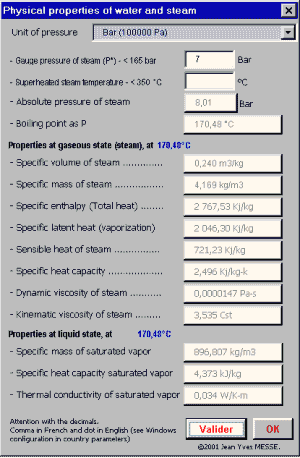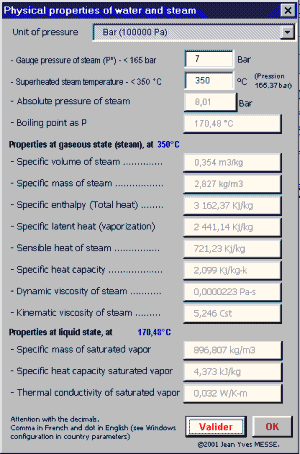| Saturated steam or wet steam, overheated steam, Mass flow of the vapor, Dry Saturated Steam - pressure low steam - pressure high steam. |

| _You are in the heading |
|
|
The vapor escapes to the laws from perfect gases.
The variations of the parameters such as "density, rate of flow, etc," cannot be expressed by simple formulas. Lexicon employed for the steam (see
steam table)
Dans le programme ThermoVapor, il y a module de calcul intégré qui permet d'établir toutes les caractéristiques physiques de l'eau, de la vapeur et de la vapeur surchauffée.
Le calcul des caractéristiques physiques de la vapeur saturée (1) peut se faire soit à partir de la pression relative ou inversement en fonction de la température de la vapeur ou des deux paramètres dans le cas d'utilisation de la vapeur surchauffée (2) Conventional designations of the types of heating
In the industrial facilities and domestics the vapor meets in 2
forms:
Recommendations for the installations of steam
For all piping (vapor, water), a minimal slope of 1 mm/m is respected, in the normal direction of flow of the fluid, in order to allow the extraction of the purging of it (vapor) and with 3 mm in the case of direction of contrary flow. Recommendations for the installations of steam The maximum temperature of the saturated steam at 0.5 relative
bar is of 111.63 °C. The steam pressure must be equal to the sum of the steam pressure necessary to the input of the transmitter of heat and the pressure losses in the steam pipes and all the accessories placed in the piping (Valves, filters, elbows, etc.)
Overheated steam: The specific heat of the steam lies between 2.08 and 6.7 kj/kg
°C (according to the pressure of use) For the networks of big length the overheated vapor avoids the
presence of condensates which can be formed only if the vapor is
saturated. That makes it possible to reduce the unnecessary thermal losses
due to the cooling of piping. The coefficient of transfer of the vapor in the course of désurchauffe
is low compared to at the saturated vapor. This property can impose the installation of a desurchauffor. Example: Exchanger supplied with overheated steam at 190°C
and water exit at 88°C. Under the pressure of use, the condensation
of water occurs at 110°C Knowing that the apparatus restores 12 liters of water per hour,
what is the transmitted thermal power?
Last update:
|
Copyright © 2003-2014 - ThermExcel - All Rights Reserved

